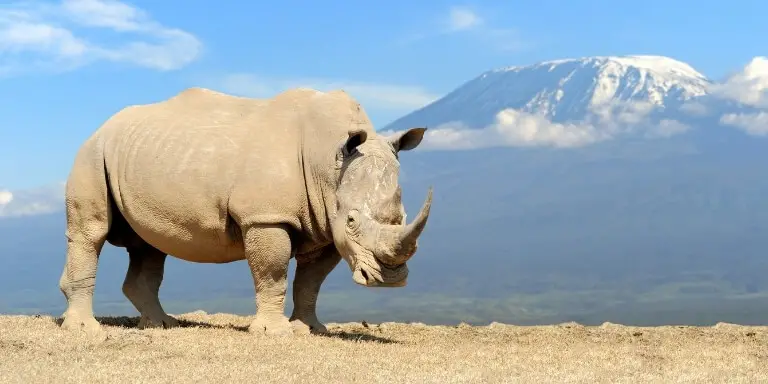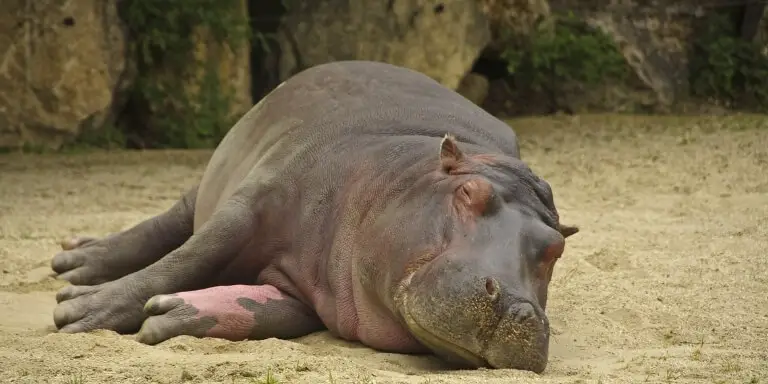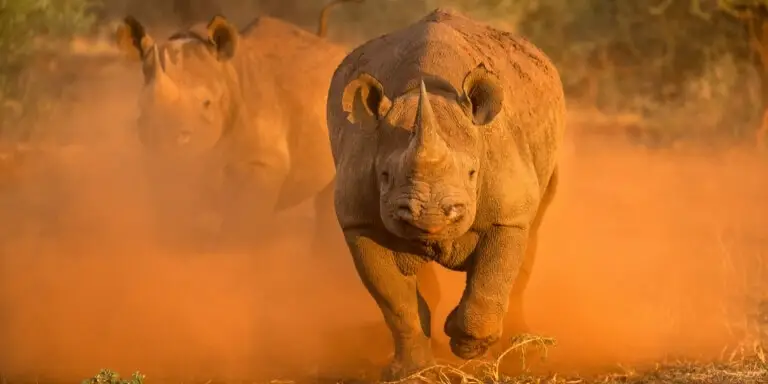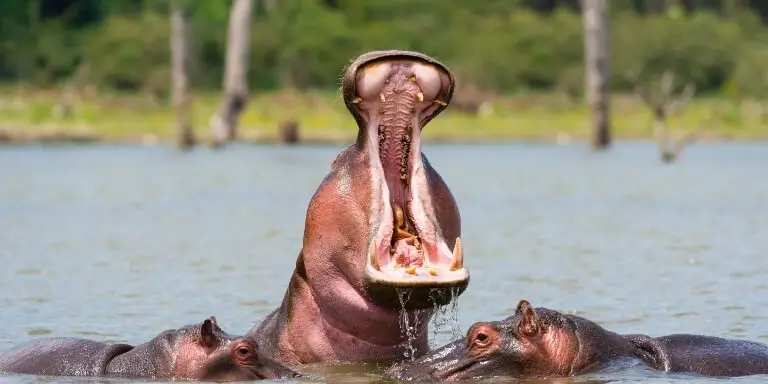Who would win the fight between rhino vs hippo?
Questions like this are blooming all over the internet every day. Can you imagine what a fight it would be like? They’d be pumped with blood, aggression, weight, power, and whatnot. Nobody wants to encounter such a thing on a nice peaceful safari.
But which animal is more aggressive? Are rhinos stronger than hippos? Most importantly, what causes them to show so much aggression? Find all the answers today.

Rhinoceros Vs Hippoptamus – Comparison Chart
| Comparison with | Rhinoceros | Hippopotamus |
|---|---|---|
| Scientific classification | Belongs to the family named Rhinocerotidae. | Hippopotamus amphibious |
| Types | Five species of rhinoceroses are alive & breathing till today. They are -white rhinos, Javan rhinos, black rhinos, the Indian ones(named as the greater one-horned), and finally the Sumatran species. | Only two species of hippopotamuses are found in the wild. One is the common hippo. The other is their tiny version known as the pygmy hippo. |
| Size | The shoulder of an adult white rhinoceros can easily surpass the head of a 6 feet tall man. | An adult hippo can touch the shoulder of a 5 feet tall human. |
| Weight | Male rhinos weigh up to 2300 kilograms & Females weigh up to 1800 kilograms. | Male hippos can weigh up to approximately 1800 kilograms. Females can weigh up to 1400 kilograms. |
| Body | Looks more like a moving rock. Have a heavy & stocky body shape. The neck is short compared to the body. Carry horns & humps with them. Have got 3 hoofed toes. Eyesight is very poor. | Bulky & gigantic body shape. Looks like a giant barrel. Have stuffed legs. The Head is smaller compared to the body. Eyes & nostrils are on top of the head. Have an enormous jaw & a tiny tail. |
| Skin & Hair | Has hairy skin. Skin thickness is around 1 to 5 centimeters. Skin is not bulletproof. | Hippo has skin with a thickness of 6 centimeters or 2 inches. Has no hair on their bodies. The skin is considered bulletproof. Has no sweat glands but oozes out an antibacterial red fluid. |
| Horn | Can have single or double horns. | Has no horn. |
| Mouth | Different species of rhinos have different-shaped mouths. In general, their lips & teeth are designed for grazing & grabbing leaves & branches. | Have a gigantic mouth that can open at 180 Degree. Have bigger & sharper teeth. |
| Toes | Have 3 toes on each foot. | Have 4 toes on each foot. |
| Speed | Around 35 mph. | Around 29 mph. |
| Diet | Herbivore. | Principally herbivore. But arguably omnivore. |
| Behavior | Black rhinos are territorial creatures & highly aggressive. White rhinos are known more for their sociable nature. | Extremely aggressive beasts. Might attack immediately if provoked. Highly territorial. |
| Habitat | Prefer widely open grasslands. Are found in Africa & Asia. Mostly found in tropical & subtropical areas & also deserts. | African animal. All of their population is found throughout Africa. Prefer shallow lakes or swamps with ample vegetation nearby. |
| Population | Though their population was a lot at the beginning of the 20th century, now many subspecies have become critically endangered & are on the verge of extinction. The white rhino population right now is around 17000 to 19000. Around 6000 black rhinos are alive in the wild. Their numbers are declining daily. | Around 150,000 common hippopotami are ruling the canals of Africa. Another subspecies, the pygmy hippos are not so lucky. Around only 2000 pygmies are left in the wild. |
| Lifespan | The life expectancy of the rhinos varies from species to species. Typically they tend to live a life of 35 to 50 years in the wild. | Common hippos can live up to 40 to 50 years out in the wild. But in captivity, there exist records of a hippo exceeding 61 years. |
| Conservation status | The Rhinoceros population has dramatically declined since 1970. All of their species are listed as “Endangered” on the IUCN red list. Three of those species are listed as “Critically Endangered”. | Common hippos are listed as “Vulnerable” on the IUCN red list. Pygmy hippos are listed as “ Endangered” on the IUCN red list. |
| Predators | Rhinoceroses are principally threatened by hunters & poachers. The majestic animal gets hunted for its jaw-dropping horns. | Hippos aren’t vulnerable to any predators. No carnivore likes to shove something that huge down its throat. Though people hunt them for their teeth & meat. |
Hippo vs Rhino Ancestor
The ancestors of hippopotamuses were discovered in most recent times when the rock beds of Kenya were excavated. Experts say that the animal in the picture was only a bit bigger than the sheep. Carbon dating has disclosed the fossils to date back to somewhat 28 million years.
The design of the dental fragments has proven the fossil to be the ancestors of modern-day hippopotamuses. Once it was thought that hippos are closely related to pigs. But later discoveries have proven the closest relatives of hippos to be whales & dolphins.
In the case of rhinos, they have many species & subspecies (5 species & 11 subspecies to be exact). The name rhinoceros literally means “nose horn”. Greek “rhino” means nose & “ceros” means horn. But all of them come from the same ancestors categorized as odd-toed-ungulates in the mammalian order.
Animals with hooves are called ungulates. The Rhinoceros’ evolution is more complex & lengthy. They lived through many rough & tough conditions of the ancient earth. Millions of years ago the rhino family was the largest living creature walking on earth. The modern-day rhinos are believed to originate from 2 to 4 million years to more than 15 million years.
Rhino types vs hippo types
Rhinoceros have a larger family than hippos. Their relatives are widened throughout the planet.
There are 5 principal species & 11 subspecies of them living in the tropical or subtropical forests, grasslands & deserts of Africa & Asia.
The five main species include-
- The Sumatran rhino (Scientific classification:
Dicerorhinus sumatrensis) - The Black rhino (Scientific classification: Diceros bicornis)
- The Javan rhino (Scientific classification: Rhinoceros sondaicus)
- The greater one-horned rhino, or the Indian rhino (Scientific classification: Rhinoceros unicornis)
- & finally the White rhino (Scientific classification: Ceratotherium simum).
The Hippo family is relatively small. There are only two species of hippos living on the planet right now. Their permanent home is the canals, rivers & swamps of great Sub-Saharan Africa.
The two species include-
- The common hippopotamus or the river hippopotamus (Scientific classification: Hippopotamus amphibious)
- & the pygmy hippopotamus (Scientific classification: Choeropsis liberiensis).
Read: Pygmy Hippo vs Regular Hippo | Comparison
Comparison of physical features
Hippopotami & rhinoceros have their obvious physical differences. Where the hippos are shaped like a huge barrel, the rhinos have a resemblance to a walking rock. Let’s get into the topic right away.


Body
The first impression of a rhino is its immense armored body. Along with the breathtaking horns on its large head. Its kneck is relatively short. White rhinos have broad chests & a huge hump on their backs. Indian rhinoceros’ body is covered with pronounced folds from its silver brown skin.
The hippos give an impression of an overgrown cow. Their small stubby legs are strong enough to carry their massive weight. Nobody can go without noticing the enormous mouth a hippo has. Its sharp teeth can be used both as a weapon & a food grinder. Their skin gives away a grayish tone. They also have a tiny tail which is used for territory marking while excretion.
Size & weight
Both the animals are known for their enormous size. Male & female white rhinoceros can grow up to 6.10 feet tall. Their body length ranges from 12 to 14 feet. They have a tail that is about 3 feet long. Males can weigh up to 2300 kilograms. Females weigh around 1800 kilograms.
Hippopotami have a height of about 5 to 5.5 feet. The bulky-bodied water cows can have a body length of around 9 to 16 feet. Their tail is about a foot or a half long. The average weight for male hippopotamuses is 1800 kilograms. Females however carry a weight of around 1400 kilograms.
Color
A fun fact about the rhinoceros is that the white rhinos aren’t actually white & the black ones aren’t literally black. White rhinos give away a yellowish-brown feature. The greater one-horned rhino carries silver-brown skin. Sumatran species publish a redding brown vibe. Black rhinos are similar to the white ones in color. Javan species have a grayish skin tone.
Hippopotami carry a purple-gray or slate-colored skin tone. Some viewers have claimed to see them sweating blood. But we all know that is just its very own antibacterial sunscreen. The fluid is originally colorless but turns reddish-orange when exposed to the sun. The surroundings of their eyes & ears give away a brownish pink feature.
Skin & hair
Rhinos have very tough skin. The skin is about 2 inches thick. But unfortunately, the blood vessels are closer to the skin surface making them vulnerable to hunters.
In fact, it is also susceptible to sunburn. Moreover, rhino skin acts as a host for mites providing a snack for various birds. Rhinos also have sparse hair all over the body but Javan & Indian ones are hairless. Sumatran species are seen with dense hair when they are calves.
On the contrary, hippopotamuses have visually hairless skin. It is very thick & acts as protection against predators. It can thicken from up to 4 to 5 centimeters.
Horns
Rhino horns are made of keratin. That is the substance of human hair & nails. The horn isn’t attached to the skull & has no bone in its structure. Black rhinos however have two horns on their long faces. The front one can grow up to 20 inches. Indian rhino has a single horn of 9 to 10 inches in length.
Similarly, Javan species have a single keratin horn with 25 centimeters in length. Sumatran rhino has two horns where the major one is around 8 inches tall. The white rhino species also has two horns above the snout.
Because of their majestic horns, rhinos are hunted in massive numbers. Moreover there exist superstitious beliefs that the rhino horns have healing power to severe diseases. These horns are as well as used in fights between males & for protection against predators
Hippos have no horns.
Mouth
The white rhinos have square-shaped lips for grazing. Black rhinos have hook-shaped pointy lips allowing them to reach for branches & leaves. Indian rhinoceros also have a slightly hooked upper lip.
The Javan & Sumatran species also own pointy lips for reaching out for fruits, grasses & twigs. Indian species have sharp front teeth from fighting with the competition.
The river hippopotamuses have massive jaws. The jaw hinges are way in the back of the head allowing the giant open mouth of about 180 degrees.
The front teeth are used in a fight & the back molars are used for vegetation grinding. Their incisors can grow up to 1.2 feet. Canines grow out around a mind-blowing 1.5 feet.
Rhinoceros vs Hippopotamus- Behavior
It isn’t uncommon to wonder which animal is more dangerous: rhino or hippo?

Rhinoceros are solitary beings. They like to roam alone except when they’re mating or with a calf. The white rhinoceroses tend to be more social & live in groups of 10 to 15. They are territorial beings & mark their borders with urine. Males often fight each other to claim territory.
They hate it when their land is under attack.
Rhinoceros usually like to avoid human contact. But if you provoke them, they’d straight up charge towards you. They have pretty poor vision. So the charge is just a blind effort to scare his intruders away.
Rhinoceros like to keep their feet on land. They don’t prefer being soaked in water. White rhinos, however, are seen to roll in mud if the weather is too hot. The species are active on both days & nights. So safaris should always keep their eyes open while in a rhino inhabited area.
The common hippopotami are fairly territorial beings. Not to mention they’re super aggressive though they don’t quite seem so. They take it personally when they see something between them & their water.

A charging male hippopotamus is the last thing you want to face on a safari. Hippos kill around 500 people per year in Africa. They live in large groups of twenty or more. They stay submerged in the swamps during the day.
The stubby-legged cows are nocturnal animals. Often hippo encounters take place after sunset. So keep an eye out in the wild while in hippo inhabited areas. Look out for hippo lawns created by excessive hippopotamus grazing.
Diet
Rhinos & Hippos both are herbivorous animals.
Black rhinoceroses like fresh juicy leaves & fruits. They have big molars for grinding. White rhinos with their flat upper lips can’t grab leaves & berries from trees. They follow a grazing lifestyle because of their flat upper lips. The other species eat similar herbs & can eat from the tree if they like.
Tender small grass is the first thing on a hippo’s menu. They also love vegetables & eat a lot every night. But hippos can show unusual behavior & feed on flesh. They often hunt impalas, kudus, or buffalos.
Where do Hippo and Rhino live?
Tropical & subtropical grasslands, shrublands, tropical moist forests & deserts are the preferred habitat for a rhinoceros. About 98% of the black rhino population is discovered in just four states: South Africa, Namibia, Zimbabwe & Kenya. Javan rhinoceroses are found in Indonesia.
The greater one-horned ones are found in the tropical forests of India & Nepal.
Shallow rivers, canals, or swamps with small grass & vegetables nearby are the dream home for common hippopotamuses. They are found all over Sub-Saharan Africa. The smaller species live in the rainforests of West Africa.
Population & reproduction
After the 1970s, the population of rhinoceros has decreased dramatically. 17,000 to 19,000 white rhinos are still living in the wild. Only around 6000 black rhinos are still roaming in Africa.
Sumatran & Javan rhinos are critically endangered with less than 80 specimens left in the wild.
Rhinoceros pregnancy can last from 15 to 18 months. Rhinos give birth to a single calf.
About 125,000 to 150,000 hippopotami are ruling the rivers of Sub-Saharan Africa. Zambia (40,000) & Tanzania (20,000 to 30,000) possess the largest populations. The mother Hippo gives birth to a single calf after a gestation period of 8 months.
Predator attacks
Can anything kill a hippo or a rhino?
Rhinos are hunted by poachers for their prominent horns. The keratin horns are often used as trophies or decorations. These are considered to have healing powers for severe diseases. It is only a myth. Lions & crocs can attack the calves.
Hippopotami are often hunted by a very ferocious predator & that’s humans. They are hunted for their teeth & meat. But occasionally lions, hyenas & crocodiles prey on the younger calves.
Conservation statuses
Black, Javan & Sumatran rhinoceroses are critically endangered. The white & Indian rhinoceroses are endangered species. Through various anti-poaching organizations, the rhino population is increasing in some parts. The IUCN has listed the common hippos as vulnerable & pygmy hippos as endangered.
Six interesting facts about rhino vs hippo
- Rhinos are heavier than hippos.
- Rhinos can’t swim. Neither can hippos.
- Both their babies are named calves.
- A group of rhinos is called a crash & a hippo group is called a bloat.
- Hippopotami communicate by making sounds & rhinoceros communicate by their dung.
- Rhinoceros have grown a symbiotic relationship with the oxpecker birds. Hippopotami also seem to have similar relationships with barbel fish.
Conclusion
The rhino vs hippo debate is still ablaze. New facts are being discovered every day. Rhinos have prominent horns whereas hippos possess the longest teeth. Both limbs they use as weapons.
Rhinoceros are heavier than hippopotamuses. Then again, hippos are more aggressive than rhinos. In conclusion, they’re both incredible creatures & should be conserved in the wild.
